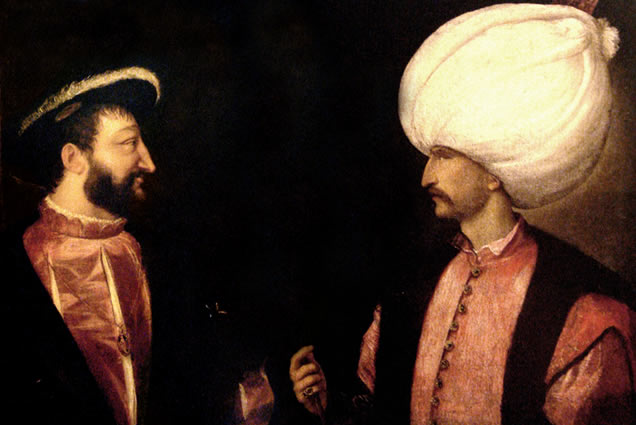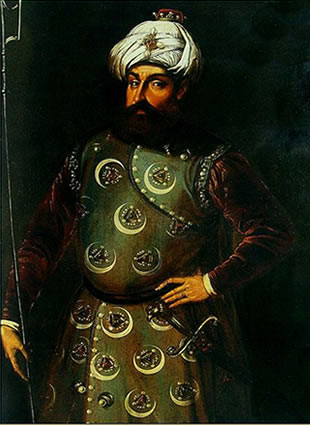- Sultan Suleiman II
On the right Sultan Suleiman II
- Byzantine Empire
Byzantine Empire
- Byzantine Empire
Byzantine Empire
- Barbarossa
Barbarossa
- Archbishop of Aegina - Agios Dionysios
Archbishop of Aegina - Agios/ Saint Dionysios
- Archbishop of Aegina - Agios Dionysios
Archbishop of Aegina - Agios/ Saint Dionysios
The years under Turkish rule
Part one
Aegina was part of the Byzantine (eastern Roman) Empire from 395-1204 CE. From the early 13th century until the first quarter of the 19th century, Aegina endured the successive rule of Franks, Catalans, Venetians and Turks, with two periods of rule alternating between Venetians and Turks. The last period of Turkish rule terminating effectively in 1792 with the surprise attack on Turkish officials in Aegina by Greek revolutionaries, well before the official start of the Greek War of Independence, dated at 1821.
Background
The Venetian rulers of Aegina were not very good at protecting Aegina against pirate attacks, which had been ongoing and devastating over the course of centuries in the Aegean. The pirates were Turks, Latins and Greeks, though by the 16th century, the official Turkish fleet also participated, along with its pirate admiral, Barbarossa, in the repression of both Greeks and Venetians in Aegina. In 1502, the Sultan's fleet, under Admiral Kemal Peis, seized the fortified hill capital of Paleohora (see article), plundering it and taking 2,000 prisoners. All of the islands of the Aegean suffered slaughters, mostly of the men, and captivity of women and children, mostly from pirates, during that period.
In 1537, Turkish Sultan Suleiman II ordered Barbarossa's fleet to destroy Corfu (Kerkyra in Greek), in reprisal for the Holy War the Venetians had declared against Islam. Though failing to take Corfu, he spread destruction throughout the Ionian Sea, and won a sea battle against the combined Venetian naval fleets off of the Ionian coast near mainland Preveza, after which Turkish dominion spread throughout the Mediterranean.
Barbarossa's raid of Paleochora (1537)
The climax for Aegina occurred the following month, with the large raid ordered by the Sultan, to be carried out under Barbarossa. It was this raid which forced the Venetians to surrender in 1540 to the Sultan, ushering in the first period of Turkish rule. The Aeginitans and Venetians at first tried to prevent the disembarkation of the pirates at the coast, but were forced to withdraw to the castl/ fortress at Paleochora. They resisted the attackers for four days, followed by having the city burned (except for its churches), the castle demolished, trees cut down, foundations dug up. Of a population of 9,000, some 3000 men and elderly women were slaughtered. 6,000 Women and children captured and either sold as slaves, taken to harems in the East, or used as oarsmen for ships' galleys. All goods were plundered from the city, which was left in ruins and deserted, though a few escaped to the mountain or hid in caves. A depiction of the attack was carved into the porous stone of the church of Agios Dimitrios.
Aegina island population after Barbarossa's raid
There are differing accounts as to how long and to what extent Aegina island was deserted after this devastating event, but most agree that it was later colonized by Albanians (Arvanites) who came over from the Peloponisos (Peloponnese), with yet more disagreement about to what extent Arvanitika (the medieval Albanian dialect) was spoken on the island. A foreign traveler in 1570 reports an estimated population of 1,000 souls on the island.
First Period of Turkish rule (1540-1687)
With the forced surrender of the Venetians to the Sultan, Turkish rule was first established in Aegina. Rebuilding of Paleochora by the Aeginitans began, and there was a brief period of tranquility, but it was short-lived, as pirate invasions continued as before. From 1576-1579, Aegina's Archbishop was Dionysios, his follower, Niphon, serving from 1608-1618, with no one holding that position during the long interim. The inhabitants of Paleochora, from around 1622, were involved in agriculture, producing cotton, wheat, almonds, figs, grapes, and honey. They also practiced piracy (!), setting Venetian ships afire after plundering them. In 1654 or 1655, the Venetian senate retaliated by sending Admiral Francis Morosini, who spent 8 days plundering, bombing and committing atrocities, taking with him between 300-800 Aeginitans (who were, by that time, mostly Arvanites), as well as 40 Turks for the ships. Only 60 houses remained in the castle of Paleochora, with 800 in ruins in the town outside of it.
Greeks were governed by officials called vovoids, who were fellow Greeks assigned to their positions from Constantinople and who often heavily taxed their fellow Greeks on their produce and paid low prices for goods which were then resold on the European market at a good profit. There were also Greek councils that regulated Greek affairs, these Greeks said to be more honest than the Turks.
During the Turkish-Venetian war of 1645-69, (in which the antagonists collaborated with pirates), islanders in all of the Aegean were attacked and sometimes tortured. During the 1660s, some 900 men were captured in Aegina and sent to work in quarries in Crete, this from a total population of 3,000, two thirds of which were women and girls, thus leaving the island demographically unbalanced, resulting in economic decline and increased poverty. In 1671, pirates seized Turkish ships with Aeginitan captains who had brought wealth to the island via commerce with Chios, Smyrna, Constantinople and Alexandria, and took food, crops, animals, leaving the island in a miserable state.
Text by Souzana Raphael
Aegina was part of the Byzantine (eastern Roman) Empire from 395-1204 CE. From the early 13th century until the first quarter of the 19th century, Aegina endured the successive rule of Franks, Catalans, Venetians and Turks, with two periods of rule alternating between Venetians and Turks. The last period of Turkish rule terminating effectively in 1792 with the surprise attack on Turkish officials in Aegina by Greek revolutionaries, well before the official start of the Greek War of Independence, dated at 1821.
Background
The Venetian rulers of Aegina were not very good at protecting Aegina against pirate attacks, which had been ongoing and devastating over the course of centuries in the Aegean. The pirates were Turks, Latins and Greeks, though by the 16th century, the official Turkish fleet also participated, along with its pirate admiral, Barbarossa, in the repression of both Greeks and Venetians in Aegina. In 1502, the Sultan's fleet, under Admiral Kemal Peis, seized the fortified hill capital of Paleohora (see article), plundering it and taking 2,000 prisoners. All of the islands of the Aegean suffered slaughters, mostly of the men, and captivity of women and children, mostly from pirates, during that period.
In 1537, Turkish Sultan Suleiman II ordered Barbarossa's fleet to destroy Corfu (Kerkyra in Greek), in reprisal for the Holy War the Venetians had declared against Islam. Though failing to take Corfu, he spread destruction throughout the Ionian Sea, and won a sea battle against the combined Venetian naval fleets off of the Ionian coast near mainland Preveza, after which Turkish dominion spread throughout the Mediterranean.
Barbarossa's raid of Paleochora (1537)
The climax for Aegina occurred the following month, with the large raid ordered by the Sultan, to be carried out under Barbarossa. It was this raid which forced the Venetians to surrender in 1540 to the Sultan, ushering in the first period of Turkish rule. The Aeginitans and Venetians at first tried to prevent the disembarkation of the pirates at the coast, but were forced to withdraw to the castl/ fortress at Paleochora. They resisted the attackers for four days, followed by having the city burned (except for its churches), the castle demolished, trees cut down, foundations dug up. Of a population of 9,000, some 3000 men and elderly women were slaughtered. 6,000 Women and children captured and either sold as slaves, taken to harems in the East, or used as oarsmen for ships' galleys. All goods were plundered from the city, which was left in ruins and deserted, though a few escaped to the mountain or hid in caves. A depiction of the attack was carved into the porous stone of the church of Agios Dimitrios.
Aegina island population after Barbarossa's raid
There are differing accounts as to how long and to what extent Aegina island was deserted after this devastating event, but most agree that it was later colonized by Albanians (Arvanites) who came over from the Peloponisos (Peloponnese), with yet more disagreement about to what extent Arvanitika (the medieval Albanian dialect) was spoken on the island. A foreign traveler in 1570 reports an estimated population of 1,000 souls on the island.
First Period of Turkish rule (1540-1687)
With the forced surrender of the Venetians to the Sultan, Turkish rule was first established in Aegina. Rebuilding of Paleochora by the Aeginitans began, and there was a brief period of tranquility, but it was short-lived, as pirate invasions continued as before. From 1576-1579, Aegina's Archbishop was Dionysios, his follower, Niphon, serving from 1608-1618, with no one holding that position during the long interim. The inhabitants of Paleochora, from around 1622, were involved in agriculture, producing cotton, wheat, almonds, figs, grapes, and honey. They also practiced piracy (!), setting Venetian ships afire after plundering them. In 1654 or 1655, the Venetian senate retaliated by sending Admiral Francis Morosini, who spent 8 days plundering, bombing and committing atrocities, taking with him between 300-800 Aeginitans (who were, by that time, mostly Arvanites), as well as 40 Turks for the ships. Only 60 houses remained in the castle of Paleochora, with 800 in ruins in the town outside of it.
Greeks were governed by officials called vovoids, who were fellow Greeks assigned to their positions from Constantinople and who often heavily taxed their fellow Greeks on their produce and paid low prices for goods which were then resold on the European market at a good profit. There were also Greek councils that regulated Greek affairs, these Greeks said to be more honest than the Turks.
During the Turkish-Venetian war of 1645-69, (in which the antagonists collaborated with pirates), islanders in all of the Aegean were attacked and sometimes tortured. During the 1660s, some 900 men were captured in Aegina and sent to work in quarries in Crete, this from a total population of 3,000, two thirds of which were women and girls, thus leaving the island demographically unbalanced, resulting in economic decline and increased poverty. In 1671, pirates seized Turkish ships with Aeginitan captains who had brought wealth to the island via commerce with Chios, Smyrna, Constantinople and Alexandria, and took food, crops, animals, leaving the island in a miserable state.
Text by Souzana Raphael
| Advertisements: | ||



